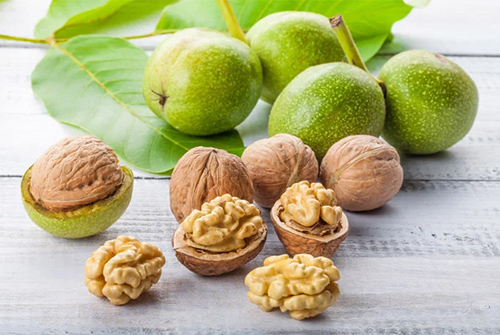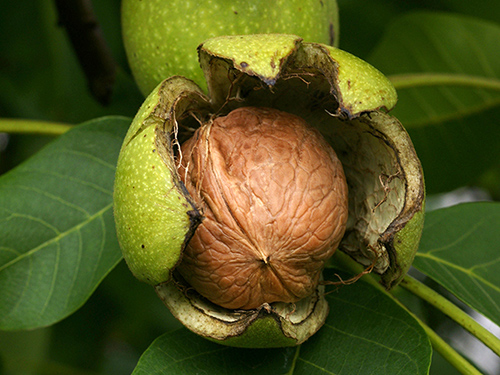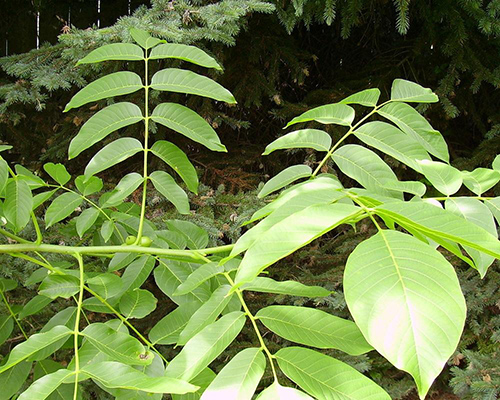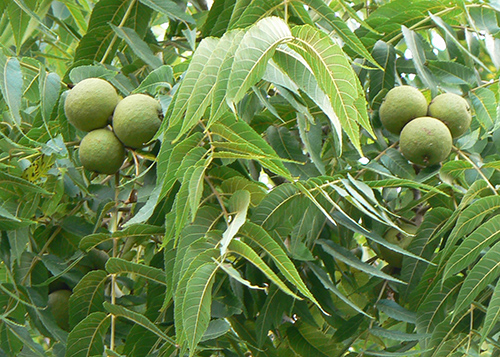Contents
The majestic English walnut tree lives up to its scientific name. Its magnificent appearance drew the attention of ancient physicians and physiotherapists, though they could not give a worthy measurement of its nutritional and medicinal virtues. The great Greek physician, pharmacologist, botanist, and author Pedanius Dioscorides thought walnuts “increase the temper” and could harm the stomach. Andres de Laguna, a Spanish physician of the 16th century, translated the works of Dioscorides into Spanish and even said that “the shadow of the English walnut tree is heavy and harmful for every animal, especially when sleeping under that tree.”

From the 18th century onwards, chemical and nutritional research proved that the English walnut tree and walnuts have many healing properties. Today, we know that walnuts have a high nutritional value, with contents of proteins similar to that of meat, which they overcome regarding the quality of fats contained and the number of vitamins and minerals they have.
We have to remark that walnuts are the endocarp or the bones of the fruit, whose edible interior is the seed. The pericarp or rind of the green walnuts is the outer part of the fruit, fleshy and green, and though inedible as it is, along with the leaves, it is the part most used in phytotherapy because of its medicinal properties.

Healing Properties and Indications
Both the LEAVES and the green covering of the fruit contain a high amount of tannins of the garlic and the catechin types (9-11 percent), which give the solid astringent properties of walnut; they also contain anthraquinone derivatives, the most important of which is juglone, a bitter substance which, along with vitamin C and organic acids, explains the antiseptic, cicatrizant, invigorating, vermifuge, and hypoglycemic properties. Its main applications are the following:
- Digestive disorders. The English walnut tree leaves and green rinds’ powerful astringent properties make them useful in all cases of diarrhea, gastroenteritis, colitis, stomach upset, and flatulence.
Walnuts stimulate the digestive organs, increasing appetite, speeding up food passing through the stomach, and secreting bile and pancreatic juice. Eating walnuts will improve the health of people suffering from dyspepsia or lack of appetite and those recovering from any disease. - Gynecological disorders. Leukorrhea (white flux), cervicitis or colpitis (inflammation of the womb neck), and ulceration on the womb neck are the ailments for which walnut has the most critical applications. Its anti-inflammation and antiseptic actions are pretty effective when administered in the form of vaginal irrigation.
But caution! Before applying any treatment for such female ailments, a gynecologist must check and evaluate the case to ascertain whether malignant or cancerous reasons cause these ailments. Vaginal irrigations must never be applied during pregnancy. We recommend taking an infusion and irrigations to achieve a more intense effect. - Urethritis (inflammation of the urethra or urinary tract) and cystitis: Apply a decoction of English walnut tree leaves and/or green rind through a urinary catheter. This will heal the itching and irritation felt when urinating and reduce the inflammation of the urinary mucosa.
- Skin and mucosal afflictions. A decoction of English walnut tree leaves or green rind applied to the skin is good whenever an astringent, wound-healing, and anti-inflammatory action is required: eczema, impetigo, folliculitis, ringworm, and wounds and sores that will not heal. Chilblains, tonsilitis, pharyngitis, conjunctivitis, and hemorrhoids are some of the afflictions that will notably improve with this decoction.
- Intestinal parasites. The vermifuge action is more intense with green rinds than with leaves.
- Diabetes. Both the English walnut tree leaves and the green rind of walnut have a mild hypoglycemic effect (decreasing blood sugar level). Though these substances alone are not enough to treat diabetes, they can be a helpful complement to other dietary measures since they allow you to reduce the dosage of antidiabetic medicines.
The seeds of the fruit, that is to say, the walnuts, contain fifteen percent proteins with a high biological value, sixty percent fats, composed of linoleic and linolenic acids, and significant amounts of calcium, phosphorus, and vitamins A, B1, B2, and B6. Well chewed, they make a very nutritional food, ideal for athletes, students, and teenagers. They are recommended for people suffering from tiredness, asthenia, or nervous system disorders. As has been proven, such habitual consumption of walnuts decreases the cholesterol level in the blood.
Walnuts and Cholesterol

On March 14, 1993, the prestigious medical magazine the New England Journal of Medicine published the results of some research conducted by Dr. Joan Sabate at the School of Public Health at Loma Linda University (USA), in which he proved that regular consumption of walnuts could reduce the level of cholesterol in the blood. So, some diets against cholesterol, which forbid the consumption of walnuts and dried fruits, were shown to be wrong.
Despite walnuts containing up to sixty percent fat, these substances are mainly formed by polyunsaturated fatty acids (especially linoleic and linolenic acids), a proportion seven times higher than saturated fatty acids.
The latest research proves unsaturated fatty acids reduce cholesterol production, mainly found in vegetables. Hence, consuming walnuts and other dried fruits does not produce cholesterol or reduce output.
Black Walnut
Black or American walnut, common in some American countries, is native to North America. It has rough, dark or black bark. Its properties are similar to those of the European walnut. Besides the rind of its green fruits, its bark is also used in decoction (30-40 g per liter of water) because of its astringent properties. The indications of this decoction are similar to those of walnut leaves and the rind of green fruits.
English Walnut Tree Scientific Facts

- Scientific synonyms: Juglans duclouxiana Dode.
- Other names: European walnut, walnut.
- French: Noyer.
- Spanish: Nogal.
- Environment: The English walnut tree is native to central Asia but has now spread to Central and Southern Europe and North America. It usually grows in sheltered valleys and sandy soils.
- Description: This tree of the Juglandaceae family grows up to 30 m high. It has grayish bark and long-petioled leaves. It has two types of flowers, male and female. The fruit is drupes (walnuts).
- Parts of the plant used medicinally: The leaves and the fruit.
How to use English Walnut
- Infusion with 10-20 g of leaves and/or rind of green fruit per liter of water. Drink three or four cups daily. This infusion must not be taken with other plants or pharmaceutical preparations containing iron salts, jelly, mucilage, or alkaloids, which could neutralize its effects. Take it alone or, if preferred, sweetened with honey.
- Decoction with 20 g of the rind of green fruit per liter of water. As a vermifuge, drink two cups daily.
- An external decoction made with 100 g of English walnut tree leaves and or rind of green fruits per liter of water, boiling for 15 minutes. Apply in vaginal irrigations, urethral cleansing, eye baths (conjunctivitis), sitz baths (hemorrhoids), compresses or baths on the skin, or in gargles (pharyngitis). We recommend taking two or three applications daily.
DISCLAIMER: All content on this website is presented solely for educational and informational objectives. Do not rely on the information provided as a replacement for advice, diagnosis, or treatment from a qualified medical expert. If you are pregnant, nursing, or have any preexisting medical concerns, talk to your doctor before using any herbal or natural medicines.
REFERENCES
- George D. Pamplona-Roger, M.D. “Encyclopedia of Medicinal Plants.” George D. Pamplona-Roger, M.D. Encyclopedia of Medicinal Plants. Ed. Francesc X. Gelabert. vols. 2 San Fernando de Henares: Editorial Safeliz, 2000. 505, 506, 507. Print. [English walnut tree]
- https://www.webmd.com/vitamins/ai/ingredientmono-127/english-walnut
- https://www.ncbi.nlm.nih.gov/pmc/articles/PMC9510174/
- https://www.rxlist.com/supplements/english_walnut.htm
